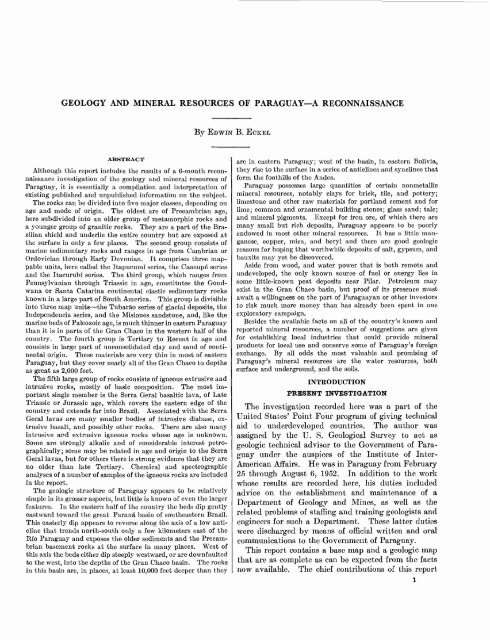Geology and Mineral Resources of Paraguay A Reconnaissance
Geology and Mineral Resources of Paraguay A Reconnaissance
Geology and Mineral Resources of Paraguay A Reconnaissance
- No tags were found...
You also want an ePaper? Increase the reach of your titles
YUMPU automatically turns print PDFs into web optimized ePapers that Google loves.
GEOLOGY AND MINERAL RESOURCES OF PARAGUAY A RECONNAISSANCEBy EDWIN B. ECKELABSTRACTAlthough this report includes the results <strong>of</strong> a 6-month reconnaissanceinvestigation <strong>of</strong> the geology <strong>and</strong> mineral resources <strong>of</strong><strong>Paraguay</strong>, it is essentially a compilation <strong>and</strong> interpretation <strong>of</strong>existing published <strong>and</strong> unpublished information on the subject.The rocks can be divided into five major classes, depending onage <strong>and</strong> mode <strong>of</strong> origin. The oldest are <strong>of</strong> Precambrian age,here subdivided into an older group <strong>of</strong> metamorphic rocks <strong>and</strong>a younger group <strong>of</strong> granitic rocks. They are a part <strong>of</strong> the Brazilianshield <strong>and</strong> underlie the entire country but are exposed atthe surface in only a few places. The second group consists <strong>of</strong>marine sedimentary rocks <strong>and</strong> ranges in age from Cambrian orOrdovician through Early Devonian. It comprises three mappableunits, here called the Itapucumi series, the Caacup6 series<strong>and</strong> the Itacurubi series. The third group, which ranges fromPennsylvanian through Triassic in age, constitutes the Gondwanaor Santa Catarina continental clastic sedimentary rocksknown in a large part <strong>of</strong> South America. This group is divisibleinto three map units the Tubarao series <strong>of</strong> glacial deposits, theIndependencia series, <strong>and</strong> the Misiones s<strong>and</strong>stone, <strong>and</strong>, like themarine beds <strong>of</strong> Paleozoic age, is much thinner in eastern <strong>Paraguay</strong>than it is in parts <strong>of</strong> the Gran Chaco in the western half <strong>of</strong> thecountry. The fourth group is Tertiary to Recent in age <strong>and</strong>consists in large part <strong>of</strong> un consolidated clay <strong>and</strong> s<strong>and</strong> <strong>of</strong> continental origin. These materials are very thin in most <strong>of</strong> eastern<strong>Paraguay</strong>, but they cover nearly all <strong>of</strong> the Gran Chaco to depthsas great as 2,000 feet.The fifth large group <strong>of</strong> rocks consists <strong>of</strong> igneous extrusive <strong>and</strong>intrusive rocks, mostly <strong>of</strong> basic composition. The most importantsingle member is the Serra Geral basaltic lava, <strong>of</strong> LateTriassic or Jurassic age, which covers the eastern edge <strong>of</strong> thecountry <strong>and</strong> extends far into Brazil. Associated with the SerraGeral lavas are many smaller bodies <strong>of</strong> intrusive diabase, extrusivebasalt, <strong>and</strong> possibly other rocks. There are also manyintrusive <strong>and</strong> extrusive igneous rocks whose age is unknown.Some are strongly alkalic <strong>and</strong> <strong>of</strong> considerable interest petrographically;some may be related in age <strong>and</strong> origin to the SerraGeral lavas, but for others there is strong evidence that they areno older than late Tertiary. Chemical <strong>and</strong> spectrographicanalyses <strong>of</strong> a number <strong>of</strong> samples <strong>of</strong> the igneous rocks are includedin the report.The geologic structure <strong>of</strong> <strong>Paraguay</strong> appears to be relativelysimple in its grosser aspects, but little is known <strong>of</strong> even the largerfeatures. In the eastern half <strong>of</strong> the country the beds dip gentlyeastward toward the great Parana1 basin <strong>of</strong> southeastern Brazil.This easterly dip appears to reverse along the axis <strong>of</strong> a low anticlinethat trends north-south only a few kilometers east <strong>of</strong> theRio <strong>Paraguay</strong> <strong>and</strong> exposes the older sediments <strong>and</strong> the Precambrianbasement rocks at the surface in many places. West <strong>of</strong>this axis the beds either dip steeply westward, or are downfaultedto the west, into the depths <strong>of</strong> the Gran Chaco basin. The rocksin this basin are, in places, at least 10,000 feet deeper than theyare in eastern <strong>Paraguay</strong>; west <strong>of</strong> the basin, in eastern Bolivia,they rise to the surface in a series <strong>of</strong> anticlines <strong>and</strong> synclines thatform the foothills <strong>of</strong> the Andes.<strong>Paraguay</strong> possesses large quantities <strong>of</strong> certain nonmetallicmineral resources, notably clays for brick, tile, <strong>and</strong> pottery,limestone <strong>and</strong> other raw materials for portl<strong>and</strong> cement <strong>and</strong> forlime; common <strong>and</strong> ornamental building stones; glass s<strong>and</strong>; talc;<strong>and</strong> mineral pigments. Except for iron ore, <strong>of</strong> which there aremany small but rich deposits, <strong>Paraguay</strong> appears to be poorlyendowed in most other mineral resources. It has a little manganese,copper, mica, <strong>and</strong> beryl <strong>and</strong> there are good geologicreasons for hoping that worthwhile deposits <strong>of</strong> salt, gypsum, <strong>and</strong>bauxite may yet be discovered.Aside from wood, <strong>and</strong> water power that is both remote <strong>and</strong>undeveloped, the only known source <strong>of</strong> fuel or energy lies insome little-known peat deposits near Pilar. Petroleum mayexist in the Gran Chaco basin, but pro<strong>of</strong> <strong>of</strong> its presence mustawait a willingness on the part <strong>of</strong> <strong>Paraguay</strong>an or other investorsto risk much more money than has already been spent in oneexploratory campaign.Besides the available facts on all <strong>of</strong> the country's known <strong>and</strong>reported mineral resources, a number <strong>of</strong> suggestions are givenfor establishing local industries that could provide mineralproducts for local use <strong>and</strong> conserve some <strong>of</strong> <strong>Paraguay</strong>'s foreignexchange. By all odds the most valuable <strong>and</strong> promising <strong>of</strong><strong>Paraguay</strong>'s mineral resources are the water resources, bothsurface <strong>and</strong> underground, <strong>and</strong> the soils.INTRODUCTIONPRESENT INVESTIGATIONThe investigation recorded here was a part <strong>of</strong> theUnited States' Point Four program <strong>of</strong> giving technicalaid to underdeveloped countries. The author wasassigned by the U. S. Geological Survey to act asgeologic technical advisor to the Government <strong>of</strong> <strong>Paraguay</strong>under the auspices <strong>of</strong> the Institute <strong>of</strong> Inter-American Affairs. He was in <strong>Paraguay</strong> from February25 through August 6, 1952. In addition to the workwhose results are recorded here, his duties includedadvice on the establishment <strong>and</strong> maintenance <strong>of</strong> aDepartment <strong>of</strong> <strong>Geology</strong> arid Mines, as well as therelated problems <strong>of</strong> staffing <strong>and</strong> training geologists <strong>and</strong>engineers for such a Department. These latter dutieswere discharged by means <strong>of</strong> <strong>of</strong>ficial written <strong>and</strong> oralcommunications to the Government <strong>of</strong> <strong>Paraguay</strong>.This report contains a base map <strong>and</strong> a geologic mapthat are as complete as can be expected from the factsnow available. The chief contributions <strong>of</strong> this report
















